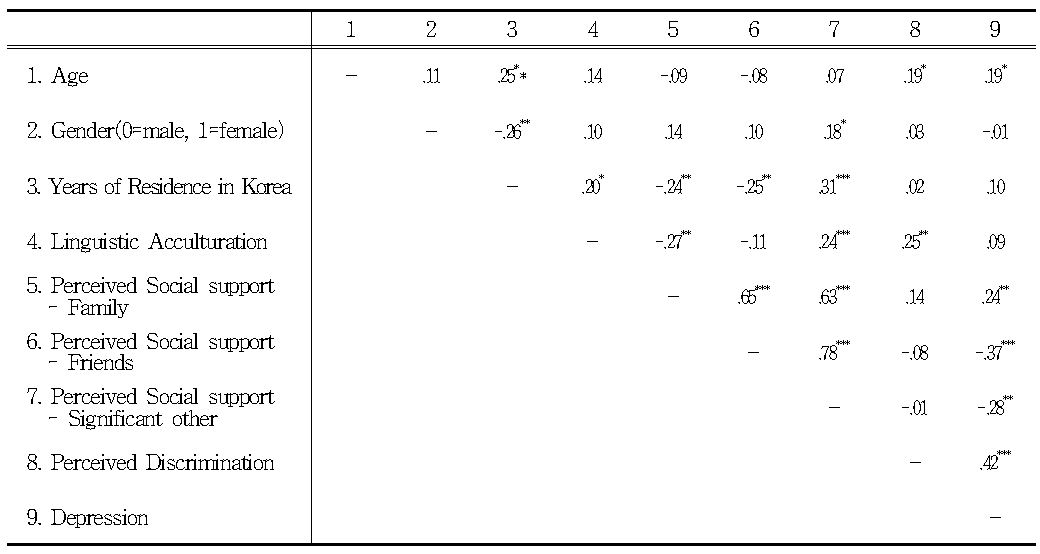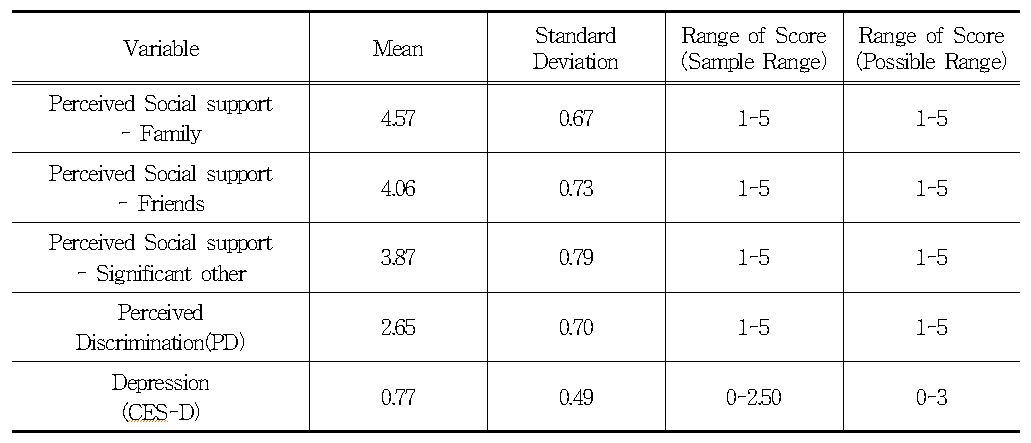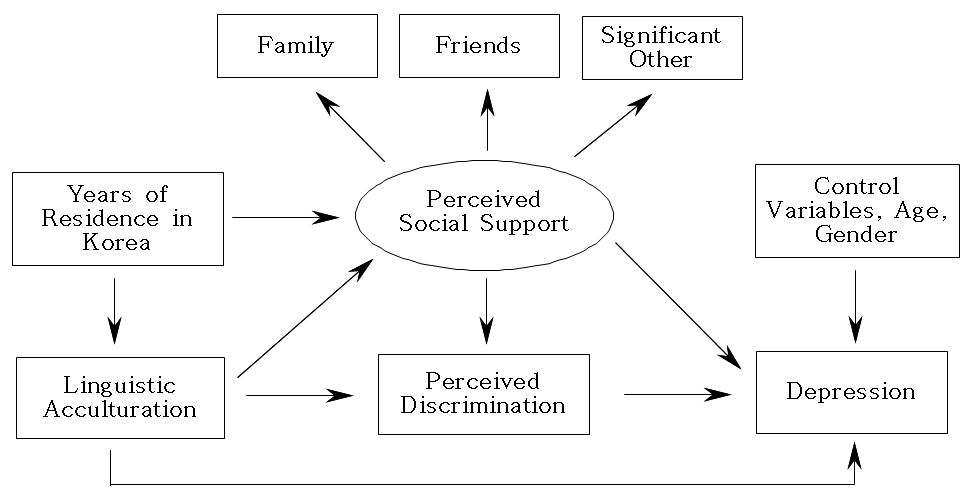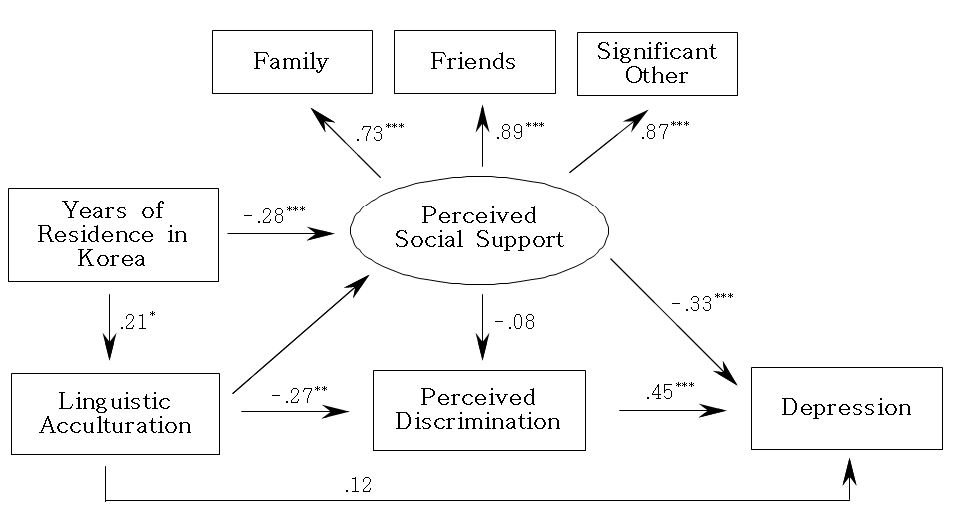


본 연구는 한국에 거주하는 중국유학생들의 우울에 이르는 경로를 연구하기 위하여 AMOS 프로그램을 사용하였다. 본 연구에서는 중국유학생의 우울에 영향을 주는 변인으로 거주기간, 한국어 구사 능력, 사회적 지지와 인지하는 차별의 연구모형으로 구성하여 우울에 이르는 경로를 분석하였다. 본 연구의 조사대상자로 129명의 중국유학생들이 참여 하였고, 연구 도구로는 CES-D(우울증), MSPSS(사회적지지), PD(인지하는 차별)을 사용하였다. 인구학적 변인으로 한국어 구사능력, 한국어 이해능력, 거주기간, 성별 등을 포함시켰다. 통계는 SEM(Structural Equation Modeling)을 사용하였는데 연구 결과는 사회적 지지와 인지하는 차별은 중국유학생의 우울에 직접적인 영향을 주었다. 또한 거주기간은 사회적 지지를 통하여 우울에 간접적인 영향을 주었고, 언어 구사능력은 인지하는 차별을 통하여 우울에 간접적인 영향을 주었다. 이러한 결과에 근거하여 중국유학생들의 우울의 완화를 위한 사회복지 개입전략을 제시하였다.
South Korea has experienced a recent rapid increase in the number of foreign residents, marking a 420% increase in the number of registered foreigners between 1999 and 2009 (Korea Immigration Service, 2009). The number of international students in South Korea has alsoincreased dramatically in the past decade. Along with increasing globalization, the Korean government’s emphasis on promoting internationalization of higher education institutions in recent years (e.g., Study Korea Project) has brought significant numbers of international students to colleges and universities in South Korea (Ahn & Choi, 2008). Between 2000 and 2007, the number of international students who enrolled in higher educational institutions in South Korea increased from 6,160 to 49,270, an increase of 700%(Ahn & Choi, 2008).
Compared to their native counterparts, international students experience additional, unique challenges in the process of adjusting to the neweducational and social environments in the host country. These challenges include, but are in no way limited to, language difficulties, discrimination, cultural differences, social isolation, and homesickness (Poyrazli & Lopez, 2007; Swagler & Ellis, 2003). They often contribute to adverse mental health outcomes, including depression (Rahman & Rollock, 2004; Wei et al., 2007; Yi, et al., 2003). Recent decades have seen a growth of interest in research related to understanding mental health among international students (e.g., Constantine, et al., 2004; Wei, et al., 2008;Yen, et al., 2000). However, much of the previous research has been conducted on students in the United States. Relatively limited attention has been focused on international students in other countries, especially South Korea. Students from China were selected for this particular study because they are the most represented international students in South Korea, composing nearly 70% of the international student population (Ahn & Choi, 2008).
Despite the increase in the numbers of foreign resident, Korean culture still centers upon a singular race, ethnicity, and language. This could potentially limit the ethnic subcultures into which people with different racial/ethnic backgrounds might be integrated. In fact, Korea and China have been categorized as “East Asia,” which is characterized by a “collectivistic” and “Confucian”culture. However, intra-East Asian variations in Confucianism and collectivism have been reported in a number of studies (Choi & Han, 2009; Kim, 2009). In addition, both countries have markedly different social, political, and economic environments. Studies have indicated that Chinese students in South Korea experience multiple challenges in the process of adjusting to Korean society, including stereotypes and prejudice about Chinese culture, discrimination, language barriers, financial hardship, social isolation, cultural differences (e.g., interpersonal relationship), etc. (Cui, 2008; Lim, 2009). The purpose of the current study was to examine factors associated with depressive symptoms among Chinese international students in South Korea. This study was particularly interested in the ways in which years of residence, linguistic acculturation, perceived social support, and perceived discrimination affect depressive symptoms.
1. Years of Residence, Linguistic Acculturation, Perceived Discrimination, and Depression
Acculturation can be defined as the process of cultural and psychological change in cultural groups, families, and individuals following intercultural contact(Berry, 2007). The process of acculturation often accompanies difficulties and stressors, which are referred to as acculturative stress (Joiner & Walker, 2002; Mena et al., 1987). Perceived discrimination, defined as “a sense of being differentially treated in public places or of being barred access to sources of information, social networks, and peer groups based on group membership”(Mesch, et al., 2008), has been treated as the main component of acculturative stress in a number of studies (Finch, Kolody, & Vega, 2000; Moradi & Risco, 2006; Poyrazli & Lopez, 2007; Sandhu & Asrabadi, 1994; Wei et al., 2008; Ying, et al., 2000). International students are typically minority group members in regard to race, ethnicity, and/or language, and perceived discrimination is considered the most common stressor in the process of acculturation among this population (Sandhu & Asrabadi, 1994).
Acculturation has been operationally defined in a number of ways in the literature. Along with years spent in the host country, language proficiency, as the mean of communicating with host-culture members and understanding host cultures, have been the most utilized operationalized definitions of acculturation (Cherpitel & Borges, 2002; Jasinskaja-Lahti & Liebkind, 2007; Lin & Betz, 2009). Several studies have reported that the language dimension of acculturation (e.g.,host language use, preference) was likely to directly affect depressive symptoms (Sumer et al., 2008).
Studies have consistently confirmed that acculturative stress is a significant predictor of depressive symptoms (Constantine et al. 2004; Shin, et al., 2007; Wei et al., 2007; Wei et al., 2008). In particular, perceived discrimination has been reported to be related to psychological distress or depressive symptoms (Finch et al., 2000; Hwang & Goto, 2008; Liebkind & Jasinskaja-Lahti, 2000; Moradi & Risco, 2006; Wei et al., 2008). For example, Moradi and Risco (2006) sampled 128 Latino immigrants and found that perceived discrimination was related to greater psychological distress. Hwang and Goto’s (2008) study, which utilized a sample of 186 Asian American and Latino college students, indicated that perceived discrimination was associated with increased risk for clinical depression. Wei et al. (2008) sampled 354 international students in the U.S. from Asian countries and found that perceived discrimination predicted depressive symptoms. The authors also mentioned that perceived discrimination had a unique contribution to depressive symptoms beyond the effects of general life stress.
Other studies have examined the role of acculturative stress in the acculturation-mental health link (Jasinskaja-Lahti & Liebkind, 2007; Jung, et al., 2007; Oh, et al., 2002; Shen & Takeuchi, 2001).
Jung et al. (2007) sampled 218 international students and reported that low levels of acculturation were related to higher perceived discrimination, which, in turn, increased depressive symptoms. Oh et al. (2002)examined a sample of 157 Korean Americans and found that low levels of linguistic acculturation were related to higher levels of acculturative stress, which, in turn, was related to increased depressive symptoms. Jasinskaja-Lahti and Liebkind (2007) reported that perceived discrimination was a mediating factor between linguistic acculturation and psychological well-being. However, the direction of the relationships between acculturation and perceived discrimination was opposite that of a study by Oh et al. (2002). Higher linguistic acculturation was related to higher perceived discrimination, which, in turn, reduced psychological well-being (Jasinskaja-Lahti & Liebkind, 2007).
2. Years of Residence, Linguistic Acculturation, Perceived Social Support, and Depression
Social support has been identified as a significant protective factor against psychological distress in immigrants (Chou, 2009; Han et al., 2007; Hovey & Magana, 2002; Shin et al., 2007; Sumer et al., 2008). Utilizing a sample of 440 international students in the U.S., Sumer et al. (2008) reported that among study variables, social support was the most significant factor influencing depressive symptoms. This finding suggests that lower levels of perceived social support arerelated to higher levels of depressive symptoms. Hovey and Magana (2002) studied 75 Mexican immigrant farm workers in Ohio and Michigan and reported that lower levels of perceived effectiveness of social support were related to higher depressive symptoms. Similarly, Shin et al. (2007) examined a sample of 147 Korean immigrants in the U.S. and found that higher levels of perceived social support were related to lower depressive symptoms.
Several studies have suggested that social support plays a mediating role between level of acculturation and psychological distress. Miller et al.’s(2006) study, which utilized 226 women in the U.S. who had originated from the former Soviet Union, suggested that although years of residence and acculturation (measured by English language fluency and American behavior) were not directly related to depressive symptoms, they indirectly influenced depressive symptoms by contributing to social alienation and family and personal stressors. The study suggested that longer residencein the U.S. and higher levels of acculturation were related to reduce social alienation, which led to less family and personal stress, and subsequently to decrease depressive symptoms. Lim, et al.’s (2008) study of 128 Korean American breast and gynecological cancer survivors reported similar results the effect of acculturation on depressive symptoms was indirect via network structure and emotional social support.
3. Social Support and Perceived Discrimination
Several studies have indicated that social support is associated with perceived discrimination or other types of acculturative stress (Olaniran, 1993; Poyrazli, et al., 2004; Tartakovsky, 2007; Ye, 2006). Ye (2006) examined a sample of 112 Chinese international students in the U.S. and found that those who were more satisfied with their interpersonal support networks reported less perceived discrimination. Similarly, Poyrazli et al. (2004) sampled 141 international students in the United States and found that higher levels of social support were related to lower acculturative stress. Tartakovsky (2007) studied a sample of 211 high school adolescents who immigrated from Russia and the Ukraine to Israel, and reported that perceived social support from peers was negatively correlated with acculturative stress. In a qualitative study of 17 immigrants from India to America, Bhattacharya (2008) found that social support from peers was the most useful resource for relieving acculturative stress.
4. Gender, Age, and Depression
The major focus of this study was to investigate the relationships between years of residence, linguistic acculturation, perceived social support, perceived discrimination, and depressive symptoms. However, gender, age were also examined as possible confounding covariates. Gender was included in several previous studies and has been found to be a significant predictor of depression (Gonzalez & Gonzalez, 2008; Noh, et al., 1992; Tinghog, et al., 2007). However, Sumer et al. (2008) and Constantine et al. (2004) reported no significant relationship between gender and depression. Age was a predictor of depressive symptoms in studies by Oei and Notowidjojo (1990) and Trouillet and Gana (2008), but no significant relationship was found in Sumer et al.’s (2008) study.
The purpose of the current study was to examine factors associated with depressive symptoms among Chinese international students in South Korea, with a particular focus on the effects of years of residence, linguistic acculturation, perceived social support, and perceived discrimination. Relying on a review of the above-mentioned literature, the current study developed and tested a model that is presented in Figure 1. It was hypothesized that linguistic acculturation, perceived social support, and perceived discrimination would have significant direct relationships with depressive symptoms. It was also hypothesized that years of residence in Korea would have an indirect effect on depressive symptoms via linguistic acculturation and perceived social support. Linguistic acculturation was hypothesized to have an indirect effect on depressive symptoms via perceived social support and perceived discrimination. Finally, it was hypothesized that perceived social support would influence perceived discrimination. Gender, age, and financial hardship were used as control variables
2. Participants and Data Collection Procedures
A total of 134 international students completed the survey. Of those 134 surveys, 129 surveys indicated Chinese as their nationality. Five surveys, therefore, were eliminated from the analysis. Of the 129 respondents, approximately 43% were male (N=56) and 57% were female (N=73). Ages ranged from 19 to 25, with an average of 21. The preponderance of respondents (95%) had been living in South Korea for less than three years. All of the respondents indicated that they were single. All of the respondents were undergraduate students.
Data were collected from undergraduate students attending one large university located in an urban city in South Korea. Faculty members from several departments were contacted and a request was made for their assistance with survey distribution in their classrooms during lecture. After obtaining faculty permission, the survey packet was distributed to prospective respondents and the respondents were asked to complete the survey at the end of the class hour. To increase responses, university residence halls, which house a high percentage of the international student population, were also contacted. Research assistants went the residence hall and distributed the survey. Completed surveys were returned to the research assistants.
The survey packet consisted of a cover letter and the questionnaire. Prospective participants were told that participation in the study was voluntary and that names and other identifying information would not be collected. Survey instruments were offered in either Chinese (Mandarin Chinese) or Korean.
1) The Center for Epidemiological Studies Depression Scale (CES-D)
Depression was assessed using the Center for Epidemiologic Studies Depression Scale (CES-D; Radloff, 1977). The 20-item CES-D requires respondents to determine whether they have experienced symptoms usually associated with depression, with emphasis on the affective component and depressed mood (e.g., depressed mood, feelings of worthlessness, feeling of hopelessness, loss of appetite, poor concentration, sleep disturbance). Responses were coded on a four-point Likert scale, ranging from zero (rarely or none of the time) to three (most or all of the time). The greater the scaled score, the more likely it was that depressive symptoms were present. The CES-D has been used extensively with different ethnic groups andhas been reported to have adequate internal consistency within the Chinese population (.89 - .90) (Wie et al., 2007; Yen, et al., 2000). In this study, the Cronbach’s alpha for the CES-D was .89.
2) Multidimensional Scale of Perceived Social Support (MSPSS)
Perceived social support was measured usingthe 12- item Multidimensional Scale of Perceived Social Support (MSPSS; Zimet, et al., 1988). The MSPSS contains three subscales: perceived support from family, friends, and significant other (MSPSS; Dahlem, et al., 1991; Zimet et al., 1988). Each of the subscales contains four items. Participants were asked to rate their degree of agreement on a 5-point Likert scale, ranging from one (strongly disagree) to five (strongly agree). Greater scores indicated higher levels of perceived social support. In prior studies, the Cronbach’s alphas for the MSPSS scores ranged from .88 to .93 (Canty-Mitchell & Zimet, 2000; Zimet et al., 1988), and the Cronbach’s alphas for the Family, Friends, and Significant Other subscales were .91, .89, and .91, respectively (Canty-Mitchell & Zimet, 2000). In the current study, the Cronbach’s alpha for the MSPSS was .93, and the Cronbach’s alphas for the Family, Friends, and Significant Other subscales were .89, .87, and .82, respectively.
3) Perceived Discrimination Scale (PD)
Perceived discrimination was measured using the Perceived Discrimination Scale (PD), a subscale of the Acculturative Stress Scale for International Students (ASSIS; Sandhu & Asrabadi, 1994). The scale consists of eight items that probe unequal opportunity, bias, unequal treatment, and unfriendliness (e.g., “I am treated differently in social situations” “I feel that my people are discriminated against”). Responses were coded on a five-point Likert scale, ranging from one (strongly disagree) to five (strongly agree). Higher scores indicated greater perceived discrimination. In prior studies with international students, coefficient alphas for PD scale scores were between .90 and.92 (Jung et al., 2007; Wei et al., 2008). In the present study, the Cronbach’s alpha was .81.
4) Linguistic acculturation
Linguistic acculturationwas assessed using a composite score comprised of two items (Korean language usage and perceived Korean language fluency). Korean language usage was measured on a 3-point Likert scale in which “1”indicated Chinese only or more Chinese than Korean; “2” indicated both languages used equally; and “3” indicated more Korean than Chinese or Korean only. Korean fluency was measured on a 3-point Likert scale in which 1 = not at all fluent or not fluent; 2 = moderate; and 3 = fluent or very fluent. For the two-item linguistic acculturation, Cronbach’s alpha was .53.
Finally, information was obtained regarding years of residence in Korea, age, gender (0= male 1 = female), country of origin, marital status, and financial hardship (ranging from 1 = not at all to 5 = very much).
The CES-D, MSPSS, and PD were translated from English into both Korean and Chinese (Mandarin Chinese) by graduate students who were bilingual in English and Chinese or in English and Korean. Other questions were first developed in Korean and were translated into Chinese by a Korean-Chinese bilingual student. A committee was then formed of one Chinese faculty member from the College of Chinese Studies and two Korean faculty members from Social Work department. Within the committee, each question was discussed to assure that the translation accurately reflected the full content of the original text.
The means, standard deviations, and range of the study’s variables are presented in the Table 1.

Corelation Matrix
The CES-D scores ranged from 0 to 2.5, with a mean of 0.77(SD=0.49). The perceived discrimination scores ranged from 1 to 5, with a mean of 2.65(SD=0.70). Perceived social support from family scores ranged from 1 to 5, with a mean of 4.57(SD=0.67), social support from friends scores ranged from 1 to 5, with a mean of 4.06(SD=0.73), and social support from significant others scores ranged from 1 to 5, with a mean of 3.87(SD= 0.79).
[Table 2.] Means, Standard Deviations, and Ranges of Scores

Means, Standard Deviations, and Ranges of Scores
The correlations of the study variables are presented in Table 2. Gender and age were examined to determine whether they were confounding factors of the relationships among the study variables. The results indicated that age was significantly correlated with depressive symptoms (r = .19, p= .037). Age was also significantly correlated with perceived discrimination (r = .19, p= .029) and years of residence in Korea (r = .25, p = .005). There was no pattern of high correlations, which suggests that the covariates were not strongly related to study variables. Because of limited sample size, the researcher decided not to enter these variables as control variables in the SEM model.
Structural Equation Modeling (SEM) was used to test the model predicting depressive symptoms. The chi-square statistic (χ2) is one of the most popular ways of evaluating model fit. Since the chi-square statistic is affected by sample size, other fit indices are recommended to supplement the χ2 test (Schumacker & Lomax, 2004). In the current study, the following indices were used to measure model fit: χ2, χ2/df, Comparative Fit Index (CFI), Tucker-Lewis Index (TLI), Incremental Fit Index (IFI), and RootMean Square Error of Approximation (RMSEA). In addition, the Sobel (1982) test was used to determine whether the indirect effect of the predictor on the dependent variable through the mediator variable was significant.
The hypothesized structural model was tested with the maximum likelihood method in AMOS version 16.0. Fit indices reflected a reasonably adequate fit between the model and the sample data: χ2(10, N = 129) = 19.37, p = .036; χ2/df = 1.94; CFI = .97; TLI= .90; IFI = .97; RMSEA = .09. Standardizedpath coefficients from the latent variable perceived social support, to the three indicators (family, friends, and significant other) were .73, .89, and .87, respectively. All of the factor loadings were statistically significant (
With regard to direct relationships to depressive symptoms, a significant relationship was not found between linguistic acculturation and depressive symptoms ( = .13,
1. Implications for social work practices
This study tested a model predicting depressive symptoms among Chinese international students in South Korea. A significant relationship between linguistic acculturation and depressive symptoms was not found. As expected following the review of the literature(e.g., Chou, 2009; Han et al., 2007; Sumer et al., 2008), higher levels of perceived social support were found to significantly contribute to decreased depressive symptoms. Further examination of years in Korea, perceived social support, and depressive symptoms revealed that the longer students stayed in Korea, the less they seemed to perceive social support. This, in turn, led to an increase in depressive symptoms. Based on the correlation analyses, the inverse relationship between years of residence in Korea and perceived social support was consistently found in different sources of support: family, friends, and significant other. These findings were in contrast with Miller et al.’s (2006) immigrant study, which indicated that longer staysin the host country contributed to decreased social alienation. The process of migration often leads to the loss of the social support network that was established in the home country (Rogler, 1994; Yeh et al., 2008). Such a loss of support could be balanced by new social networks developed in the host country (Lim et al., 2008; Yoon, et al., 2008). However, international students often have limited opportunities to connect with mainstream society and/or same-ethnic communities in the host country because of barriers such as employment, lack of resources, immigration status, financial difficulties, and transportation limitations. Therefore, over time, international students may be at an increased risk of isolation.
As expected, higher levels of perceived discrimination were predictive of an increase in depressive symptoms, which was consistent with the results of previous studies (Finch et al., 2000; Hwang & Goto, 2008; Jung et al., 2007; Moradi & Risco, 2006). Further expected results related to indirect relationships revealed that perceived discrimination was a mediating variable between linguistic acculturation and depressive symptoms. In other words, greater linguistic acculturation was associated with lower levels of perceived discrimination, which, in turn, was associated with fewer depressive symptoms. These findings were consistent with the work of Oh et al. (2002).
The findings of the current study highlight the importance of social support and discrimination in depression among international students. University personnel may use time in residence and linguistic ability as barometers of psychological well-being for international students, assuming that more time in the host country and/or better linguistic ability are related to better adjustment or well-being. However, the current study suggests that other factors should be considered when understanding mental health issues among international students. University personnel and other service providers should pay attention to social supports among international students. This includes both host country and ethnically based social supports. An increase in time spent in the host country may not necessarily contribute to increased social support, especially for international students who have multiple barriers in developing networks in the host country. Although resources exist, students may not perceive personal access to these resources due to issues of cultural difference, discrimination, language, transportation, and lack of information about the resources. Service providers need to encourage students to address the barriers in keeping or developing social support networks. In addition, they should provide services that bridge students and support systems.
Perceived discrimination was the strongest predictor of depressive symptoms in the current study. International students may feel discrimination not only from the interpersonal relationships, but also from the class, campus, and community in which they reside. Although Korean society continues to become more culturally diverse, the history of this nation reflects a homogeneous national identity and culture. Ultimately, this homogenous culture has contributed to the marginalization of individuals from different national, racial, and ethnic backgrounds. It is important that universities provide culturally competent services aimed toward facilitating adjustment and lessening acculturative stress. At the same time, it is important to educate faculty, administrators, students, and community members on issues of diversity.
This study has several limitations that are important to consider when discussing the findings. First, it utilized a cross-sectional sampling approach. As a result, causality cannot be established. A longitudinal study might clarify the causal processes leading to depressive symptoms. Second, the sample of the current study was comprised of Chinese international students drawn exclusively from one university, thereby potentially limiting the generalizability of the findings. Third, this study did not consider sub-ethnicities within the Chinese group. For example, Chinese-Koreans (ethnic Koreansin China, mostly third- or fourth-generation of immigration) may differ from other groups of Chinese in adjusting to Korean society, and subsequently in mental health outcomes. Finally, future research needs to extend our understanding of risk and protective factors for depressive symptoms among international students by considering additional psychological variables, such as self-esteem and loneliness



